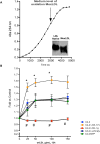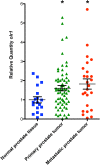Lectin-like oxidized LDL receptor-1 is an enhancer of tumor angiogenesis in human prostate cancer cells
- PMID: 25170920
- PMCID: PMC4149537
- DOI: 10.1371/journal.pone.0106219
Lectin-like oxidized LDL receptor-1 is an enhancer of tumor angiogenesis in human prostate cancer cells
Abstract
Altered expression and function of lectin-like oxidized low-density lipoprotein receptor-1 (LOX-1) has been associated with several diseases such as endothelial dysfunction, atherosclerosis and obesity. In these pathologies, oxLDL/LOX-1 activates signaling pathways that promote cell proliferation, cell motility and angiogenesis. Recent studies have indicated that olr1 mRNA is over-expressed in stage III and IV of human prostatic adenocarcinomas. However, the function of LOX-1 in prostate cancer angiogenesis remains to be determined. Our aim was to analyze the contribution of oxLDL and LOX-1 to tumor angiogenesis using C4-2 prostate cancer cells. We analyzed the expression of pro-angiogenic molecules and angiogenesis on prostate cancer tumor xenografts, using prostate cancer cell models with overexpression or knockdown of LOX-1 receptor. Our results demonstrate that the activation of LOX-1 using oxLDL increases cell proliferation, and the expression of the pro-angiogenic molecules VEGF, MMP-2, and MMP-9 in a dose-dependent manner. Noticeably, these effects were prevented in the C4-2 prostate cancer model when LOX-1 expression was knocked down. The angiogenic effect of LOX-1 activated with oxLDL was further demonstrated using the aortic ring assay and the xenograft model of tumor growth on chorioallantoic membrane of chicken embryos. Consequently, we propose that LOX-1 activation by oxLDL is an important event that enhances tumor angiogenesis in human prostate cancer cells.
Conflict of interest statement
Figures






References
-
- Sawamura T, Kume N, Aoyama T, Moriwaki H, Hoshikawa H, et al. (1997) An endothelial receptor for oxidized low-density lipoprotein. Nature 386: 73–77. - PubMed
-
- Chen XP, Du GH (2007) Lectin-like oxidized low-density lipoprotein receptor-1: protein, ligands, expression and pathophysiological significance. Chin Med J (Engl) 120: 421–426. - PubMed
-
- Chen M, Masaki T, Sawamura T (2002) LOX-1, the receptor for oxidized low-density lipoprotein identified from endothelial cells: implications in endothelial dysfunction and atherosclerosis. Pharmacol Ther 95: 89–100. - PubMed
Publication types
MeSH terms
Substances
LinkOut - more resources
Full Text Sources
Other Literature Sources
Medical
Miscellaneous

